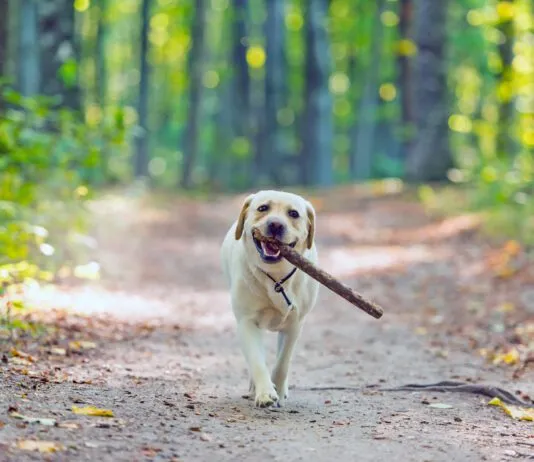(The Other End of the Leash #1) – Understanding Your Dog’s Visual Signals
Visual though primates may be, we humans often miss the signals that our dogs are sending us. For example, in my seminars I do a demonstration in which I pet and praise my Border Collie Pip for giving me a ball back. Pip is my sleeper Border Collie, who looks a bit like a goofy Labrador cross when in fact shes from pristine sheepdog lineage. But she loves balls like life itself, so to reward her for giving me the ball back, I coo to her and lavishly stroke her head. People watching respond to my efforts to praise Pip and seem to feel really good when Im done. They feel so good that they give me an A+ when I ask them to grade my efforts to make Pip glad that she gave me the ball.
(The Other End of the Leash #2) – Understanding How Your Dog Responds...
If humans are understandably a bit slow at responding to the visual signals that our dogs are sending, we are downright dense about the signals that we generate ourselves. Your dog, however, is a pro: he or she notices just about every move that you make. Here’s an experiment that you can try, focusing on the signals that you give to your dog, whether you mean to or not. This one is really easy, because now you’re the actor, and your dog is the observer. Your job is to identify the visual signals to which your dog has learned to respond.
(Managing Your Dog’s Weight # 5) – Safe Canine Weight Loss Tips
To start your dog back on the road to slimness, start by aiming for a 10 percent weight loss – or a rate of about 1 percent of his body weight per week. A slow approach is recommended both because it allows for a more gradual change in feeding, and because studies show that rapid weight loss can increase a loss of lean body mass, which in turn can contribute to weight regain. (Lean body mass, which includes organs, are the primary drivers of basal metabolism and burn energy at far higher levels than fat mass does. Reducing the amount of lean tissue can create diminished energy requirements, so a dog can regain weight even if he’s eating less.) In other words, forget the idea of crash diets for your dog; slow and steady wins this race.
(Cushing’s Disease #2) Complimentary Care for Dogs with Cushing’s Disease
Because the diagnosis and treatment of Cushing’s disease can be confusing, expensive, and fraught with adverse side effects, many caregivers turn to alternative or complementary therapies. For those who prefer treatments that have been proven in double-blind, placebo-controlled clinical trials, unconventional therapies are themselves fraught with peril. Product testimonials and anecdotal reports don’t prove anything, and by turning first to an herbal preparation or glandular extract, one might deny the patient an opportunity for effective treatment. Online reviews of nutritional supplements or herbal preparations range from reports about dogs that appear to be cured to heartbreaking stories of dogs whose condition deteriorated rapidly.
(Play With Your Dog #1) Tug Games
The game of Tug has an undeserved bad rap in some training circles, while others, most notably the Agility world, have fully embraced it as an excellent activity to create focus and high arousal. Those two extremes aside, it’s a great game just because it’s fun, many dogs adore it, it’s the perfect play activity for human family members who might otherwise want to get in appropriately physical with the dog and it’s a terrific energy-burner.
Resource Guarding – A Natural, Normal Canine Behavior.
Resource guarding is a natural, normal canine behavior. In fact it’s a normal behavior for most warm-blooded animals. Even we humans guard our resources – sometimes quite fiercely. Think about it. We lock our doors. Store clerks have loaded .22 rifles under checkout counters, while homeowners keep shotguns and baseball bats leaning in the corner by the back door. Banks keep valuables in vaults. Some of us get insanely jealous if someone pays too much attention to our significant other.
(Canine Allergies #2) – How to Stop The Itch
Most holistic veterinary practitioners recommend switching any itchy dog to a complete and balanced home-prepared diet containing “real foods.” This will decrease the dog’s exposure to unnecessary or complex chemicals and give his body the opportunity to utilize the higher-quality nutrients present in fresh foods. Whether the diet is cooked or raw, the increased nutrient quality and availability of fresh whole foods will improve the health of any dog who currently receives even the best dry or canned foods.
(Collars & Leashes #2) – The Canine Shock Collar Debate
Whole Dog Journal is against the use of shock collars under any circumstances. As our mission statement asserts, “The methods we discuss will endeavor to do no harm to dogs; we do not advocate perpetrating even minor transgressions in the name of ‘greater good.’
(Remedies for Canine Arthritis #1) – Remedies for Canine Arthritis
A conventional treatment for the discomfort of joint pain in dogs is the administration of pain-relieving non-steroidal anti-inflammatory drugs (NSAIDs), including aspirin, as well as Rimadyl, Deramaxx, and EtoGesic. These pharmaceuticals temporarily relieve pain but may also produce significant, unwanted side effects ranging from gastric upset and bleeding to liver damage and seizures. All of the NSAIDs have been plagued by reports of serious health problems resulting from their use.
(Cushing’s Disease #1) Cushing’s Disease
Clinical signs of Cushing’s, no matter its primary cause, may include one or most of the following:
• Polyuria (increased frequency of urination), polydipsia (increased thirst), and polyphagia (increased, ravenous hunger).
• Weakening and atrophy of the muscles of the extremities and abdomen, resulting in gradual abdominal enlargement, lordosis (sway back), muscle trembling, and weakness.
• Weight loss. While most dogs appear fat, they may actually lose weight due to the loss of muscle mass.
• Fat deposits in the liver, resulting in diminished liver function.
(The Encyclopedia of Natural Pet Care #3) – Natural Remedies vs. Conventional Treatments
In our age of modern medicine, when illnesses are treated in high-tech hospitals with laser surgery and powerful prescription drugs, it is easy to forget that until the 20th century, plants were the medicines that kept people and their companion animals well. In fact, most of the prescription drugs in use today were derived and synthesized from plants, and outside of Canada and the United States, plants remain the world’s primary healing agents.
Resource Guarding – What to look out for
During resource-guarding, dogs exhibit components of ritualized aggression. That is, they have a fairly explicit hierarchy of warnings – accelerated eating, cessation of eating or “freezing up,” glassy/hard eyes, growling, lip lifting, snapping, biting – that they’ll run through to get a competitor (YOU!) to back away from what they have. They’re nervous that you’re there and don’t want to share.







